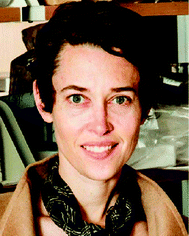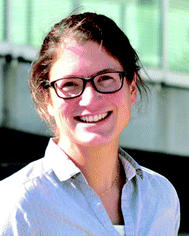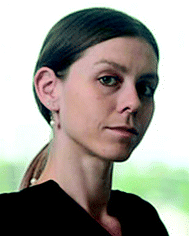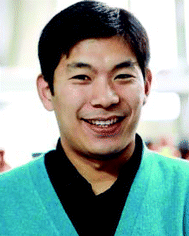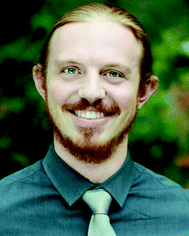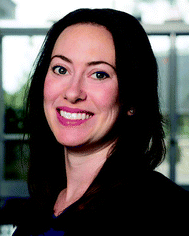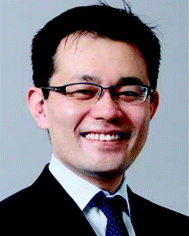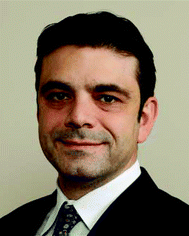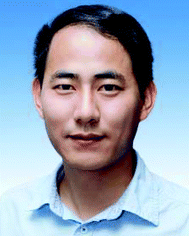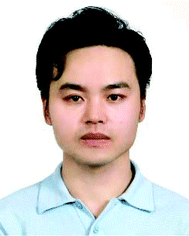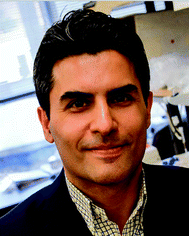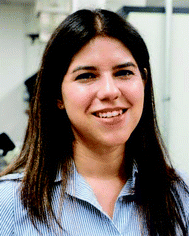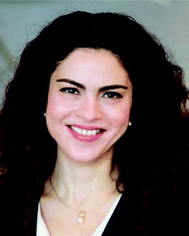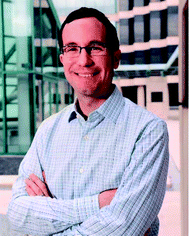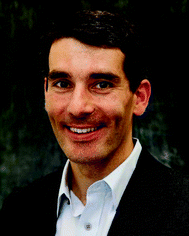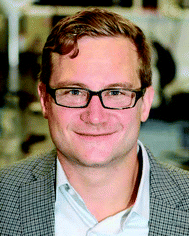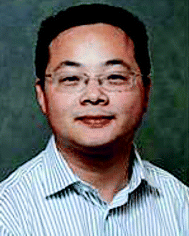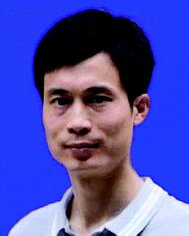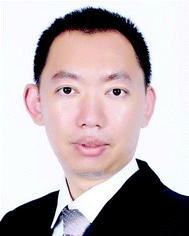DOI:
10.1039/C8BM90065E
(Editorial)
Biomater. Sci., 2019,
7, 454-460
Biomaterials Science Emerging Investigators 2019
It is with great pleasure that we present the 2019 Biomaterials Science Emerging Investigators Issue. These researchers and their contributions represent a window into the future of the biomaterials field. New strategies for the chemical and physical manipulation of materials continue to develop and there are new technologies that are sure to make an impact. Over the last few decades, biomaterial design has shifted from minimizing interactions with the body to actively engaging and modulating local and even systemic biological processes. As these new materials move from lab development to relevant preclinical models, and even to clinical testing and widespread use, we have the opportunity to carefully observe how biomaterials are functioning in complex biological environments and can ask important questions for future design. What are the therapeutically relevant factors in biomaterials design for humans? Are we targeting the right biology? Will these new materials help patients? It is critical that we ask ourselves these questions and these emerging investigators are leading the charge.
New discoveries in biology are an opportunity for advanced biomaterials design. In this issue, Rosales, Guvendiren and DeForest and their colleagues describe new chemistries that support biological modification to engage local cells and provide sequence control (DOI: 10.1039/C8BM01215F, 10.1039/C8BM01269E and 10.1039/C8BM01304G). Biological building blocks themselves can be used as biomaterial building blocks, as Bastings and colleagues review biomaterials built from DNA (DOI: 10.1039/C8BM01249K). Additional examples of peptides, proteins and sugars are found throughout the issue being used as both building blocks of base materials and ligands. While these chemical or biological ligands are frequently used to modulate cells or tissues, Cheng uses specific chemical modifications of biomaterials to prevent bacterial adhesion and activity, a critical need for devices to prevent infection (DOI: 10.1039/C8BM01211C). Physical performance, along with biocompatibility, is also required for specific clinical applications, as Zha shows in the development of tissue adhesives and device coatings (DOI: 10.1039/C8BM01186A).
Biomaterials are also applied to model physiological systems. Organoids are purely cellular structures that recapitulate elements of normal tissue development creating complex organ structures including neural, retinal, and gastrointestinal tissues. Biomaterials can work in these systems to further explore complex cell interactions in a controlled microenvironment. This is particularly relevant in tumors. Fraley uses extracellular matrix polymers to build tumor microenvironments with controlled properties (DOI: 10.1039/C8BM01188E). Elements of normal developmental processes can be mimicked with morphogen gradients, and can be applied in fields such as dentistry. Celiz focuses on dentistry specifically to describe the impact of acellular scaffolds on tissue regeneration (DOI: 10.1039/C8BM01296B). Finally, a newly emerging application of in vitro three-dimensional biomaterial culture systems in the development and preservation of follicles is presented by Shikanov (DOI: 10.1039/C8BM01253A).
Beyond biological integration with cells and tissues, biomaterials advances also focus on sensing biology. This requires biomaterials to be processed into many forms including particles and membranes. Multiple imaging modalities are developing with new biological and chemical needs. New particle advances for visualizing signals and delivering contrast agents may include specific targeting and triggers for “intelligent” imaging, as demonstrated by Huang (DOI: 10.1039/C8BM00642C). Ling reviews inorganic nanoclusters and their application in imaging (DOI: 10.1039/C8BM01200H). Membranes or similar structures are needed to perform sensing functions on tissue structures. New elastomeric materials are frequently needed for sensing applications to fully integrate with tissues. Furthermore, electrical signals are often a desired target for sensing tissue biology or integrating into scaffolds, as Siegwart and Nikkhah discuss (DOI: 10.1039/C8BM01120F and 10.1039/C8BM01050A). Fujie shows that the development of conducting materials that can be integrated into flexible membranes is critical to achieve this goal (DOI: 10.1039/C8BM01290C).
As drugs and biological therapies become more targeted for conditions including cancer and inflammation, biomaterials and drug delivery systems may provide vehicles for safer and more effective delivery. Increasing the efficacy and safety of gene therapy continues to be a focus for biomaterial drug delivery development, as shown by Silva (DOI: 10.1039/C8BM01218K). Particles can also be biological in nature as in the platelet mimics described by Brown (DOI: 10.1039/C8BM01201F). Specific and targeted delivery is important for therapies with innate toxicity of pleiotropic effects. Zhang presents delivery strategies designed to mitigate the toxicity of chemotherapy (DOI: 10.1039/C8BM01333K), Zhan employs peptides to target cancer (DOI: 10.1039/C8BM01340C), while Scott targets inflammatory pathways in osteoarthritis (DOI: 10.1039/C8BM01224E).
Excitement crosses many fields for the potential of RNA targeting and CRISPR technology, which allows specific genetic modification. Wilson delivers RNA therapies for cancer applications (DOI: 10.1039/C8BM01064A) and Xu reviews the latest applications of biomaterials for CRISPR (DOI: 10.1039/C8BM00637G). This is an area of biomaterials research that is sure to grow over the coming years.
We hope you enjoy the issue and will continue to follow the exciting developments in biomaterials science and the work of these emerging investigators.
Jennifer Elisseeff, Editor-in-Chief
Biographies of contributors
Maartje Bastings trained as a Biomedical Engineer at the Eindhoven University of Technology (TU/e) and obtained her Ph.D. in 2012, which was given the University Academic Award. Her research focused on the understanding of multivalent binding mechanisms and the development of supramolecular biomaterials. She moved to the Wyss Institute of Harvard University in Boston as a NWO Rubicon and Human Frontier Science Program postdoctoral fellow, where she focused on DNA-origami nanoparticles and their interaction with cells. Since January 2017, she has been heading the Programmable Biomaterials Laboratory as a tenure track Assistant Professor in the Materials Science and Engineering Department at EPFL, Switzerland, developing novel precision-engineered materials as tools to quantify fundamental mechanisms in biology.
Dr Ashley Carson Brown is an Assistant Professor in the Joint Department of Biomedical Engineering at North Carolina State University and the University of North Carolina at Chapel-Hill where she directs the Advanced Wound Healing Lab. Dr Brown received a B.S. in Biosystems Engineering from Clemson University and a Ph.D. in Biomedical Engineering from the Georgia Institute of Technology. Dr Brown's research focuses on creating novel biomimetic soft materials to (1) interact with the body's native healing processes to improve tissue repair outcomes and (2) better understand cellular mechanotransduction mechanisms in tissue repair.
Adam Celiz graduated with a first-class bachelor's degree from the University of Brighton in Pharmaceutical and Chemical Sciences in 2006 and gained a Ph.D. in Chemistry from the University of Cambridge in the Melville Laboratory for Polymer Synthesis in 2010. Following this, Adam performed postdoctoral research at the University of Nottingham and the Wyss Institute for Biologically Inspired Engineering at Harvard University with a Marie Curie International Outgoing fellowship. Adam's research in biomaterials has led to an Early Career Researcher Award from the American Vacuum Society's Biomaterials Interfaces Division and the Larry Hench Young Investigators Prize from the UK Society for Biomaterials. In 2017, Adam joined the Department of Bioengineering at Imperial College London as Lecturer (Assistant Professor) to develop biomaterials for tissue repair and regeneration.
Yiyun Cheng is a professor of Biomaterials at the School of Life Sciences, East China Normal University (ECNU). He received his Ph.D. from the University of Science and Technology of China in 2008 and was a postdoctoral fellow at Washington University in St Louis. He joined ECNU and started independent research in 2010. Yiyun received Distinguished Young Scholars funding from the National Science Fund of China (NSFC), and the Young Chemist Award from the Chinese Chemical Society in 2015. He was an Editorial Board member for Letters in Drug Design & Discovery, Current Drug Discovery Technologies
etc. Yiyun has published more than 100 peer-reviewed articles. His research interests focus on the development of smart polymers for the cytosolic delivery of genes, proteins, peptides.
Cole A. DeForest is an Assistant Professor in the Department of Chemical Engineering at the University of Washington. He received a B.S.E. (
Magna Cum Laude) in Chemical Engineering/Material Science (2006) from Princeton University, and subsequently earned his Ph.D. in Chemical/Biological Engineering (2011) from the University of Colorado before performing postdoctoral studies at the California Institute of Technology. His research aims to develop dynamically tunable biomaterial platforms that aid in understanding 4D biological processes and to exploit this ascertained information in the engineering of functional human tissue. When he is not writing grants or educating scientists, he loves to ski, hike, bike, run, climb mountains, cook, and spend time with his family. He is always up for good conversation or a spontaneous adventure.
Dr Stephanie I. Fraley earned her B.S. in Chemical Engineering in 2006 from the University of Tennessee, Chattanooga, and her Ph.D. in Chemical and Biomolecular Engineering in 2011 from the Johns Hopkins University. Dr Fraley joined UC San Diego in July 2014 as an assistant professor of Bioengineering. Her research takes a multidisciplinary and multi-scale approach to (1) understand the mechanisms of cell migration underlying human diseases, in particular cancer, and (2) develop clinical profiling technologies for improved understanding and treatment of human diseases. She has received a national Burroughs Wellcome Fund Career Award at the Scientific Interface for her research merging clinical diagnostic and basic research approaches. She is also a SAGE Bionetworks Scholar, Kavli Frontiers of Science Fellow, BMES CMBE Rising Star, and NSF CAREER awardee.
Toshinori Fujie, Ph.D., is an Associate Professor in the Waseda Institute for Advanced Study (WIAS) at Waseda University. He received his Ph.D. in Engineering from Waseda University in 2009. He spent postdoctoral periods at the Italian Institute of Technology (2010–2012) and Tohoku University (2012–2013), joined as an Assistant Professor of the Faculty of Science and Engineering at Waseda University in 2013, and moved to the WIAS at Waseda University in 2016. He has concurrently served as a PRESTO researcher at the Japan Science and Technology Agency (JST) since 2015. His research interests are dedicated to biomaterials, tissue engineering and biorobotics for advanced medicine and healthcare applications. His honors include The Award for Young Investigator of the Japanese Society for Biomaterials (2017) from the Japanese Society for Biomaterials, and the Young Scientists’ Prize for the Commendation for Science and Technology from the Minister of Education, Culture, Sports, Science and Technology (MEXT), Japan (2018).
Dr Guvendiren is the principal investigator of the Instructive Biomaterials and Additive Manufacturing Laboratory (IBAM-Lab) and an Assistant Professor at the New Jersey Institute of Technology (NJIT). He earned his B.S. and M.S. degrees in Metallurgical and Materials Engineering from the Middle East Technical University in Ankara (in Turkey). He earned his Ph.D. degree from the department of Materials Science and Engineering at Northwestern University, focusing on adhesion in hydrogels and glassy polymers. He did postdoctoral training at the University of Pennsylvania focusing on stem cell interactions with dynamic and patterned materials. He was a Research Assistant Professor at the New Jersey Center for Biomaterials at Rutgers University between 2013 and 2016. He joined NJIT in 2016, with a primary appointment in the Chemical and Materials Engineering Department and a joint appointment in the Biomedical Engineering Department. Dr Guvendiren has co-authored 30 research papers and 3 book chapters. His research group focuses on the development of novel biomaterials with user-defined and dynamic properties, investigation of cell–biomaterial interactions, and additive manufacturing (including bioprinting) of tissue engineering constructs. His research is currently funded by the National Science Foundation (NSF) and the New Jersey Health Foundation.
Peng Huang received his Ph.D. in Biomedical Engineering from the Shanghai Jiao Tong University in 2012. Then he joined the Laboratory of Molecular Imaging and Nanomedicine (LOMIN) at the National Institute of Health (NIH) as a postdoctoral fellow. In 2015, he moved to Shenzhen University (SZU) as a Distinguished Professor, Chief of Laboratory of Evolutionary Theranostics (LET), and Director of the Department of Molecular Imaging. His research focuses on the design, synthesis, and biomedical applications of molecular imaging contrast agents, stimuli-responsive programmed targeting drug delivery systems, and activatable theranostics.
Daishun Ling received his Ph.D. (2013) from the School of Chemical and Biological Engineering at Seoul National University. Later, he worked as a senior researcher at the Center for Nanoparticle Research, Institute for Basic Science. He joined the faculty of the College of Pharmaceutical Sciences at Zhejiang University in 2014 through “Zhejiang University 100 Talent Professor” and “National 1000 Young Talent Program”. He currently focuses on the synthesis and assembly of functional nanoparticles for biomedical applications.
Mehdi Nikkhah is currently an Assistant Professor of Biomedical Engineering at the School of Biological and Health Systems Engineering (SBHSE), Arizona State University. His laboratory research is focused on the integration of innovative biomaterials and micro/nanoscale technologies to create biomimetic tissue constructs for disease modeling and regenerative medicine applications. Dr Nikkhah completed his postdoctoral fellowship at Harvard Medical School and Harvard-MIT Division of Health Sciences and Technology (HST), working in the areas of biomaterials and regenerative medicine. He received his Ph.D. degree in Mechanical Engineering from Virginia Tech, where his research was focused on cell–biomaterial interfaces and the identification of cancer cell biomechanical signatures using isotropic microstructures. Dr Nikkhah has published more than 50 journal articles, 7 book chapters and 70 peer-reviewed conference papers (∼3700 citations, H-index of 32), and holds numerous invention disclosures and patents. He has also received many prestigious awards and recognitions during his career, some of which include: Cellular and Molecular Bioengineering (CMBE) Young Innovator Award, NSF CAREER Award, Arizona New Investigator Award, Young Investigator Award from Polymeric Materials Science and Engineering division of American Chemical Society (ACS), National Institute of Health (NIH) Ruth L. Kirschstein National Research Service Awards (NRSA) for Individual Postdoctoral Fellows, and Outstanding Ph.D. Dissertation Award at Virginia Tech.
Adrianne Rosales is an Assistant Professor in the McKetta Department of Chemical Engineering at the University of Texas at Austin. She obtained her Ph.D. in Chemical Engineering from the University of California, Berkeley, where she studied the sequence effects of biomimetic materials on polymer properties. Prof. Rosales then served as an NIH NRSA Postdoctoral Fellow and a Burroughs Wellcome Fund fellow at the University of Colorado Boulder in the field of biomaterials. She is the recipient of the BWF Career Award at the Scientific Interface, and her research interests include molecular design of biomimetic materials, dynamic polymers for cell culture, and advanced materials for biomedical applications.
Evan Scott, Ph.D., has been an Assistant Professor of Biomedical Engineering at Northwestern University since the fall of 2013. He respectively received a B.S. and Ph.D. in Biomedical Engineering from Brown University in 2002 and Washington University in St Louis in 2009. His dissertation work was performed in the laboratory of Prof. Donald Elbert, where he developed methods based in proteomics and polymer chemistry to both analyze and control the interactions between cells and material surfaces. As a Whitaker International Scholar, he spent four years in Switzerland at the EPFL performing postdoctoral research in the laboratories of Prof. Jeffrey Hubbell and Prof. Melody Swartz. There he investigated new formulations and strategies for both HIV vaccination and cancer immunotherapy. Dr Scott is a recipient of the 2015 NIH Director's New Innovator Award, the 2015 National Science Foundation CAREER Award and the 2014 American Heart Association Scientist Development Grant. He was selected as a 2017 BMES Young Innovator of Cellular and Molecular Bioengineering and a 2018 Nano Research Young Innovator in Nanobiotechnology.
Dr Ariella Shikanov is an Associate Professor in the Department of Biomedical Engineering at the University of Michigan, Ann Arbor. The research in her laboratory aims to address the current limitations in treating and preventing premature ovarian failure and creating diverse fertility preservation options for young cancer survivors. To achieve this, they create artificial constructs of ovarian tissue that direct tissue regeneration and restore biological function by combining approaches from engineering, materials, chemistry and life sciences. Dr Shikanov has received numerous awards for her excellence in research, teaching and outreach activities, including 2014 The Harwell Foundation award, 2016 National Science Foundation CAREER award, 2014 Outstanding Undergraduate Research Opportunity Program mentor and nominations for the Golden Apple Teaching award in 2017 and 2018.
Dr Daniel J. Siegwart is an Associate Professor in the Simmons Comprehensive Cancer Center and Department of Biochemistry at UT Southwestern Medical Center. He received a B.S. in Biochemistry from Lehigh University (2003), and a Ph.D. in Chemistry from Carnegie Mellon University (2008) with Professor Krzysztof Matyjaszewski. He also studied as a Research Fellow at the University of Tokyo with Professor Kazunori Kataoka (2006). He then completed a Postdoctoral Fellowship at MIT with Professor Daniel G. Anderson and Professor Robert Langer (2008–2012). The Siegwart Lab aims to discover and define the critical physical and chemical properties of synthetic carriers required for the therapeutic delivery of small (
e.g. ∼22 base pair microRNA) to large (
e.g. ∼5000 nucleotide mRNA) RNAs. Their research is grounded in chemical design and takes advantage of the unique opportunities for collaborative research at UT Southwestern.
Dr Silva is an Associate Professor in the Department of Biomedical Engineering at the University of California, Davis (USA). He received his degree in Metallurgical and Materials Science Engineering from University of Porto, Portugal. The same year that he finished his engineering degree, he was awarded a scholarship through the Gulbenkian Foundation to do his Ph.D. in Biomedicine (Gulbenkian Ph.D. Programme in Biomedicine (PGDB)), being the first engineer to be awarded this scholarship. He received his Ph.D. in Engineering Sciences: Bioengineering in 2008 while working under Prof. David Mooney's (Harvard University) supervision. After the completion of his Ph.D., Eduardo was awarded with a Wyss Technology Development fellowship (Harvard Fellow). The Wyss Institute for Biologically Inspired Engineering (Harvard University) selected fellows on the basis of their academic achievements and their technology development potential in the field of Biologically Inspired Engineering. In Nov. 2011, Eduardo joined the University of California, Davis. Eduardo has received several honors and awards, including the Metallurgical and Materials Science Engineering best student from the U. Porto, Hellman Family Fellow, invited participant on both the Frontiers of Engineering Education and Frontiers of Engineering Symposium by the American National Academy of Engineering (NAE). He has 8 patents or patent applications and one of his patents was recently licensed by Novartis. Overall, his research long-term goal is to engineer novel polymer-based vehicles for controlled delivery of cells, drugs and/or genes in the context of vascularizing ischemic tissues.
John T. Wilson is an Assistant Professor of Chemical and Biomolecular Engineering at Vanderbilt University. He received his B.S. in Bioengineering from Oregon State University and his Ph.D. from the Georgia Institute of Technology in the laboratory of Professor Elliot L. Chaikof, where he was awarded a Whitaker Foundation Graduate Fellowship. He then joined the laboratory of Professor Patrick Stayton at the University of Washington with the support of a Cancer Research Institute Postdoctoral Fellowship. He started his independent laboratory at Vanderbilt in January of 2014, where his group works at the interface of molecular engineering and immunology to innovate technologies to improve human health. His multidisciplinary research program is supported by productive and synergistic collaborations with oncologists, cancer biologists, immunologists, chemists, and other engineers. He has co-authored over 25 peer-reviewed publications and three book chapters. Since establishing his lab at Vanderbilt, he has been awarded the NSF CAREER Award, an ‘A’ Award from Alex's Lemonade Stand Foundation, a Melanoma Research Alliance Young Investigator Award, and is the recipient of an Innovative Research Grant from Stand Up To Cancer.
Dr Qiaobing Xu is currently an associate professor in the Department of Biomedical Engineering at Tufts University. He also holds adjunction position in the Department of Chemical and Biological Engineering and School of Medicine at Tufts University. He obtained his B.S. from Jilin University, Changchun, China, and Ph.D. from Harvard University, USA. He did postdoctoral training at MIT before joining Tufts in September, 2010. His current research interests lie at the intersection of material science engineering, specifically micro/nanoscience, and biomedical applications. He has received honors including awards from the Pew Scholars in Biomedical Sciences and the NSF CAREER Award.
Prof. R. Helen Zha obtained her B.Sc. in 2007 from MIT in Materials Science & Engineering. She then received her Ph.D. in 2013 from Northwestern University, where she worked under Prof. Sam Stupp as an NSF Graduate Research Fellow on self-assembling peptide-based materials. From 2013–2016, Helen pursued postdoctoral research at Eindhoven University of Technology in the lab of Prof. Bert Meijer, where she developed supramolecular materials with ordered nanostructures and photoswitchable properties. In 2016, Helen moved to the lab of Phil Messersmith at UC Berkeley, where she worked on polyphenol biomaterials and began independent research on silk-based coatings. In January 2018, Helen joined the Department of Chemical & Biological Engineering at Rensselaer Polytechnic Institute as a tenure-track Assistant Professor. Her research aims to develop biomimetic and biohybrid materials for applications in human healthcare and sustainability.
Dr Changyou Zhan is a professor of pharmacology in the School of Basic Medical Sciences, Fudan University. He obtained his Ph.D. in Pharmaceutics from Fudan University in 2010. His recent research focuses on understanding the
in vivo delivery mechanisms of liposome- and PLGA nanoparticle-based targeted drug delivery systems.
Hongbo Zhang graduated with his Ph.D. from the Faculty of Pharmacy, University of Helsinki in December 2012. He has a multidisciplinary background in pharmacy, nanotechnology, microfluidics, precision medication, and molecular biology, and he knows about world leading technologies. He has published more than 65 papers with a total impact factor of more than 500, and also has 13 corresponding research projects in Finland and in China. In the field of nanotechnology and microfluidics, he studied with Prof. David A. Weitz from Harvard University. Now he is a tenure track Assistant Professor in Åbo Akademi University and Guest Professor in Shanghai Jiaotong University. Dr Zhang also focuses on translational research and university-industry collaboration. He has broad collaborations with hospitals and he has been elected as a distinguished medical expert in Jiangsu Province. He is also the co-founder of ChinFin Incubator and Innovation Oy, in Turku.
|
| This journal is © The Royal Society of Chemistry 2019 |
Click here to see how this site uses Cookies. View our privacy policy here. 
